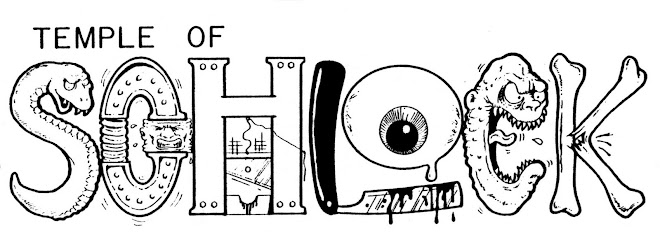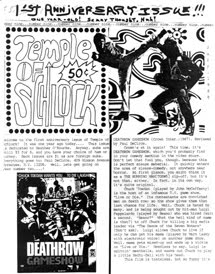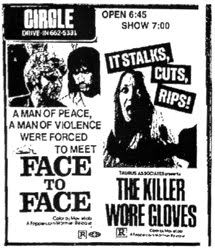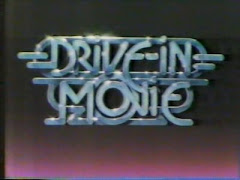Sunday, December 27, 2020
Movie Ad of the Week: BLACK ON WHITE (1969) a.k.a. THE ARTFUL PENETRATION and BARBARA THE YES GIRL (1970)
Released by Audubon Films with a self-applied X rating, Tinto Brass' pop art stunner NEROSUBIANCO/BLACK ON WHITE had its U.S. premiere in New York City on October 10, 1969. Within a few months the title was changed to THE ARTFUL PENETRATION OF BARBARA, shortened to THE ARTFUL PENETRATION for newspaper advertising.
Sporting the new title and a different advertising campaign, it returned to New York on April 22, 1970 -- with the "y" in psychological missing on the opening day ad.
A week later (May 1, 1970) the film appeared in Chicago as BARBARA THE YES GIRL with a completely different ad campaign.
Sunday, December 20, 2020
Movie Ad of the Week: KUNG FU MANIAC (1981)
BAI CU SHI FU KOU CU TOU (1979) a.k.a. THE EAGLE'S KILLER - a Hong Kong production starring Hwang Jang-Lee ("King of the Legfighters") and John Cheung (Chang Wu-liang) - was released to theaters in the U.S. by Unifilm International as KUNG FU MANIAC beginning in 1981.
Sunday, December 13, 2020
Movie Ad of the Week: SKIP TRACER (1977-1979)
If you listened to my interview on the podcast Supporting Characters last week, you heard me speaking fondly of Manhattan stores like Record Explosion and Entertainment Outlet, which had bins of cheap used VHS tapes purchased from mom & pop video shops that had gone out of business. One tape you could always find in these places (or in the 60/40's, which were porn shops that had to devote at least 60% of their floorspace to non-porn merchandise or get shut down) was the Academy Home Entertainment release DEADLY BUSINESS, which everyone avoided because of the cheesy cover photo...
...until word got out that it was actually a really good, moody, '70s character piece called SKIP TRACER, and had been the first Canadian film to play the New York Film Festival. The world premiere was at the Varsity Theater in Vancouver on July 22, 1977 during their Festival of International Films.
The film returned to the Varsity for another "world premiere" on March 28, 1978...
...before playing the New York Film Festival and landing a deal for distribution in the States.
Of all the low-budget indie distributors of the '70s, it was N.W. Russo -- whose G.G. Communications was mostly known for stateside releases of European exploitation (ONE ON TOP OF THE OTHER, A HATCHET FOR A HONEYMOON, FIND A PLACE TO DIE) and kid pics (PIPPI LONGSTOCKING, DUNDERKLUMPEN, ONCE UPON A TIME) -- who saw this downbeat, moody character piece and thought it would be a good tax shelter his golden ticket into the arthouse scene. Apart from its month-long U.S. premiere run at the Orson Welles Cinema in Boston in January-Feburary '79, SKIP TRACER doesn't seem to have gotten much of a release through Russo. The next stop was Cinemax in 1980, followed by Academy Home Entertainment's video release in 1986 (under the title DEADLY BUSINESS) and showings on the USA Network in '87 and '88. Sightings outside of Canada since the early '90s, such as a festival of Canadian tax shelter films at the Anthology Film Archives in 2015, have been few and far between -- except for Youtube.
Sunday, December 06, 2020
Movie Ad of the Week: HE KILLS WITHOUT WARNING (1981)
The Taiwanese production DA YING WANG (1978), a.k.a. THE EAGLE KING and starring Hua Tsung, was released to theaters in the U.S. beginning in 1981 as HE KILLS WITHOUT WARNING by Unifilm International.
Friday, December 04, 2020
Don't miss Chris P's first podcast appearance!
Last month Bill Ackerman of the great Supporting Characters podcast interviewed
Po Man about his "many endeavors in film culture, from co-creating the Temple Of Schlock fanzine and founding the long-running blog of the same name, to contributing to various magazines and video releases, distributing BLACK SAMURAI and working on books with Grady Hendrix, Michael Gingold and Sam Sherman. Topics include: Jack Starrett, the impact of crack on 42nd Street theatres, Steve Puchalski’s Slimetime and horror fanzines, The Journal of Interstitial Cinema, William Smith, blogathons, Paul Talbot, lost and endangered films, the link between THE GREEN HORNET and WANDA, bootlegs, THAT’S HOLLYWOOD, screenwriting for William Grefé, identifying PETS with Vinegar Syndrome and how interviews can become derailed by criminal confessions."
Check it out HERE!
Sunday, November 29, 2020
Movie Ad of the Week: CALLIOPE (1971) a.k.a. LOVE IS CATCHING (1972)
World Premiere - Wednesday, November 17, 1971 - Los Angeles, CA
After its release in Los Angeles through Allied Artists, CALLIOPE -- Matt Cimber's goofy take-off of La Ronde -- emerged a year later with a new title and ad campaign... ...opening in Pittsburgh on December 13, 1972 as LOVE IS CATCHING. Case File #107 on our Endangered List, this was one of the four AGFA prints we ran as part of the Endangered Fest II in conjunction with the Austin Film Society at the Marchesa on February 20, 2015.
Labels:
MATT CIMBER,
MOVIE AD OF THE WEEK,
WORLD PREMIERES
Wednesday, November 25, 2020
The American Dreamer and the Heyday of Campus Film Programming
The American Dreamer and the Heyday
of Campus Film Programming
by Chris Poggiali
“Film is what’s happening on campus” was a claim that 16mm rental company Ivy Film made in its advertisements in the early 1970s. During that time, clubs and organizations dedicated to film exhibition began springing up on campuses across the country, providing an unexpected but welcome boost to the non-theatrical market for the next 15 years or more – what I call the heyday of campus film programming, 1969 to 1984. You certainly didn’t see other corners of the non-theatrical world (high schools, public libraries, churches, airlines, prisons, etc.) garnering the same kind of attention during that period, and the reason is really very simple: for the first time, big money was being made at college and university box-offices.
Non-theatrical distribution was hardly the new kid on the block in the late ‘60s – Films Incorporated had represented major studios in the 16mm rental market for well over 30 years by that point – but when Oscar-nominated hits like THE GRADUATE and A MAN AND A WOMAN began to fill seats on campuses a year or two after their initial theatrical runs, a number of smaller players started to take notice: Grove Press, New Line Cinema, National Talent Service, Trans-World Films, Cannon Films, Contemporary Films, Standard Films, Select Film Library... Soon, more offbeat independent, documentary and foreign films like THE WAR GAME, SALESMAN, HIGH SCHOOL and ELVIRA MADIGAN were enjoying similar success on the suddenly lucrative campus circuit. It was only a matter of time before some enterprising group would come up with the idea of skipping the theatrical market entirely and releasing new features exclusively to college audiences.
New Line planned to do just that with SYMPATHY FOR THE DEVIL – a feature-length Jean-Luc Godard experiment starring The Rolling Stones – in the spring of 1970, but changed their tune once Grove Press sent Godard on a ten-day university lecture tour with a 16mm print of his latest film, the hour-long SEE YOU AT MAO, in April of that year. After sell-out previews at Hunter College, New Line president Robert Shaye opened the Godard/Stones pic theatrically at the Murray Hill Theater using this attention-getting exhibition strategy: Godard's original, unaltered version of the film (titled ONE PLUS ONE) would play on Mondays, Wednesdays, Fridays and Sundays, while SYMPATHY FOR THE DEVIL, producer Iain Quarrier’s shorter version, would run on Tuesdays, Thursdays and Saturdays. After a few weeks at the Murray Hill, the pic resumed its college tour and proved to be a popular catalog rental title for New Line for the next 10 years.
Later in 1970, photojournalist Lawrence Schiller and writer/filmmaker L.M. Kit Carson approached Dennis Hopper with the idea of casting him in an experimental documentary to be filmed during the editing of THE LAST MOVIE, Hopper’s eagerly anticipated directorial follow-up to EASY RIDER. Hopper initially rejected the project because of the agreement he had with Universal, which prohibited his participating in any film prior to the release of THE LAST MOVIE. “When we looked at the agreement with Universal, we saw that it was limited to theatrical,” Schiller recalls. “It was, in essence, a crack in the door which Universal had never thought of when they did the contract with Hopper.” A few months later, a new distribution outfit named EYR Programs happily kicked that door wide open when it announced that the Schiller-Carson-Hopper collaboration, titled THE AMERICAN DREAMER, would be the first feature film made exclusively for release to college campuses.
EYR, an acronym for Educational Youth Recreation, had been launched one year earlier and already had a half dozen catalog titles available for rental, including the 42 minute-long THE MAKING OF BUTCH CASSIDY AND THE SUNDANCE KID – no surprise, considering one of EYR’s founders and investors was the Sundance Kid himself, Robert Redford. Schiller, who created and directed the memorable photo montage in the middle of BUTCH CASSIDY AND THE SUNDANCE KID and was also responsible for the many iconic publicity photos associated with the film, learned of EYR’s formation when he mentioned THE AMERICAN DREAMER one day in Redford’s presence. “There was a guy by the name of Salzman running it,” Schiller says of EYR and its president, Charles C. Salzman. “I didn’t deal with Redford after that. I dealt with Salzman. An agreement was made which provided for the release of the film, under very strict conditions, on college campuses. Tickets could be sold, but that wasn’t the main motivation. The main motivation was that it was an avenue in which we could reach young people and introduce them to Dennis Hopper in a very unique way. It was another form of publicity and promotion for Hopper, to establish him as a filmmaker. You have to remember that with EASY RIDER, even though he was central to the project, in many ways he shared the credit with Peter Fonda and Jack Nicholson. [THE AMERICAN DREAMER] would establish Hopper as a filmmaker.”
An article that appeared in Variety on December 16, 1970 described EYR’s business strategy as “the “theatrical approach to the non-theatrical market,” with Salzman stating “We thought there should be a distribution entity that would take into consideration the tremendous college market with its ‘natural’ audience, which had never been harnessed properly. There was a significant source of revenue in that market which could eventually be used to finance production for non-theatrical consumers.” In Variety’s own words, EYR “thought it was wrong that only a major could distribute a film properly while non-theatrical distribution was primarily a system run by amateurs, dedicated only to the catalog conception of distribution.”
Actually, many of the so-called “amateurs” were doing just fine with the catalog approach, and some of them expanded to include newer or more prestigious studio releases. “1971 was really when the boom started for non-theatrical,” explains Steve Puchalski, founder and editor of Shock Cinema magazine. In the late ‘70s and early ‘80s, Puchalski was the coordinator for University Union Cinemas at Syracuse University, the largest campus film program in the country. “A lot of the distributors, like Kit Parker Films, had just formed and cut deals with the different majors. I think the studios thought there was a lot of money to be made suddenly, so they had contracts with the non-theatricals. Swank Motion Pictures had Columbia, Films Incorporated had Fox, UA had its own non-theatrical division. Once you could get the new releases easily, that’s really when campus programming took off.”
Meanwhile, the promotion department at EYR was working overtime to convince the film industry that the college circuit was the next big thing. The Pop Scene Service quoted Schiller as saying, “These auditoriums have an average seating capacity of 1,400. The auditorium at the University of Texas in Austin seats 2,200 and we can get 1,600 into the Hunter Hall. Not one of the college halls seats less than 600, while the average seating capacity of theaters is 450.” Elsewhere in the same article, journalist Richard L. Lewis writes “There are 3,000 campuses, according to Mary Keltz, sales director of EYR… Schiller says 800 of them have projection equipment in their auditoriums, and more than 400 now show films as part of the student activity program… [He] anticipates the average paid admission on campuses for THE AMERICAN DREAMER will be between 4,000 and 5,000. He’s estimating the potential gross at $2 million…” An article in Variety at the time predicted a $500,000 to $700,000 take for the initial one-month phase.
“Those sound like press releases,” Schiller responds when I read the quotes and figures to him. “I think we felt that each college campus could gross, for us, about $10,000 or $15,000. You have to remember, the film would only be played one night or two nights on a college campus. In those days there were film clubs or organizations on the major college campuses that showed films, mostly classic films like CASABLANCA and THE BRIDGE ON THE RIVER KWAI. Those are the clubs that we went to. So I think we were looking at grossing in the area of $10,000 a college campus. I would say $300,000 to $500,000 total gross over a nine month or a year period probably was correct. We had three or four prints made, and the whole idea was to ‘bicycle’ the prints. That’s what was done, and it started out to be very successful.”
The film premiered at the University of California, Berkeley’s Pacific Film Archive and Berkeley Art Museum on Thursday, April 22, 1971 at 10:00 p.m., followed by 15 more screenings during the next three days, while a second print was screened at Georgetown University the same weekend (April 23-25). A blurb in the Hollywood Reporter a month earlier claimed the film would play 30 campuses between April 22 and May 22 (grossing in the neighborhood of $600,000), followed by a “second wave of openings in some 300 on-campus theaters” beginning in September. L.M. Kit Carson attended press screenings and accompanied the film to 10 college campuses in April, and everything was going smoothly until an organization calling itself the Brentwood Student Film Society booked the film at the Brentwood Theater in Santa Monica on Friday, June 25, 1971. “We had made a deal with UCLA,” Schiller explains, “but EYR was not that experienced in what real creative entrepreneurs could do with film. What this film co-op at UCLA did was rent a theater off-campus. They did what is known as a ‘four wall,’ and even though they limited the admission to student body cardholders – you had to show the student body card when you bought a ticket – when this was announced, Universal went crazy. Dennis, of course, had to side with Universal. They held us and EYR Programs in breach of contract. In essence, they went for what is known as injunctive relief. Even though EYR Programs fought it, I thought Dennis was absolutely right and Universal was right, because I felt that what the film organization at UCLA had done was not ethically right. They hadn’t even told us what they were going to do. Now, they had no obligation to tell us what they were going to do, but the long and short of it is, in my opinion, they should have.”
In the end, Schiller says, Universal succeeded with their injunctive relief. “They actually went further then just stopping the film at UCLA because they convinced the judge that, hey, if this happens here, it can happen anywhere! Therefore, they were successful in the film having its release stopped.” With the exception of the campus dates that had been booked prior to the injunction, there were no more screenings after the UCLA cancellation. “Dennis had enough of his own problems with Universal in making THE LAST MOVIE that he had lost complete interest in helping us get [THE AMERICAN DREAMER] back into distribution,” Schiller states. “Now, I’m not criticizing Dennis, OK? I want to make that very clear. But the film basically disappeared, I would say, for 20 years, until one day Dennis called me and said he wanted THE AMERICAN DREAMER released. And the film went back on the road, but now to art houses and film festivals.”
In retrospect, Universal probably had grounds for an injunction several times prior to the Brentwood debacle, since the film had been shown at the Aquarius Theater on June 18th and 19th as well as The Factory, a discotheque in West Hollywood, on June 21st. After the injunction was filed, THE AMERICAN DREAMER played three weekends in Chicago (July 9-10, 16-17, 23-24) at the Broadway Broadcasting Company, a performance space that had previously hosted “underground television” video programs like Ken Shapiro’s GROOVE TUBE (CHANNEL ONE) and the Conception Corporation’s VOID WHERE PROHIBITED BY LAW. It should be mentioned that although the venue was not associated with any academic institutions in the Chicago area, the disclaimer “No one over 30 will be admitted” was added to the event listings for the third and final weekend, when the film was paired with another EYR release, DYNAMITE CHICKEN.
A more serious breach went unnoticed during its Manhattan bookings at Hunter College on the nights of May 27-29, when advertisements for the campus screenings appeared right in the middle of the New York Times theater listings two days in a row. Somehow, this violation slipped past the National Association of Theater Owners, who had real concerns regarding competition and the blurring of lines between theatrical and non-theatrical exhibition. [From the scheduling restrictions in a 1979 Swank Motion Pictures catalog: “These motion-pictures are specifically licensed for non-theatrical showings only. Advertising through media such as public radio, public television or general public newspapers is strictly prohibited. Advertising of the showings is strictly limited to the campus, grounds or premises of the organization. Advertising must be used exclusively to inform students, members or staff via on-premises bulletin boards, mail boxes, their campus newspapers or campus radio, etc. where organization announcements are regularly placed.”]
“Technically, we weren’t allowed to advertise off campus,” Puchalski admits, referring to the film program he coordinated for three years at Syracuse University. “The Post Standard and Herald Journal [newspapers] ran our listings, and [local film critic] Joan Vadeboncoeur would write an article every semester running down some of the bigger or more interesting titles on our schedule, but we weren’t allowed to actually advertise in the off-campus newspapers.”
Puchalski first saw THE AMERICAN DREAMER in 1996, when it played at the Film Forum in New York as a second feature to THE LAST MOVIE – exactly the type of double bill he would’ve enjoyed programming during his years at SU. “I became the film coordinator in 1979 and did it through ’82 when I graduated, but I had been a part of the program since ’77,” he reveals. “At the time, there were a lot of things we would try and pick up if they were obscure of if they’d gotten reviewed in New York, especially art films and foreign films. We showed a whole run of Bruno Ganz movies, like CIRCLE OF DECEIT, BLACK AND WHITE LIKE DAY AND NIGHT, KNIFE IN THE HEAD – all of those were area premieres. We had the Central New York premiere of THE STUNT MAN because no one wanted to pick it up at the time. We had it booked non-theatrically, just coincidentally, one week after the Academy Award nominations came out, and suddenly it was a surprise nominee. The theatrical distributor (Fox) even tried to have it pulled – they wanted to release it to big theaters now – but we were able to show it because the non-theatrical wouldn’t let go of their booking dates.”
The Syracuse University campus had three auditoriums suitable for projecting film. With 442 seats, Gifford Auditorium was the main venue, but right downstairs was Kittredge Auditorium, roughly half the size of Gifford and used for smaller films and older titles. There was also Grant Auditorium, a lecture hall with 400 seats, located in the law building. The seating capacity for all three venues is far below the numbers Schiller and EYR had in mind when they were booking THE AMERICAN DREAMER. If SU had been one of the 300 campuses chosen for the second wave of openings, the film probably would’ve screened in Gifford a half dozen times during the course of a weekend.
“With non-theatricals, it didn’t matter how many times you showed the film,” Puchalski explains. “It wasn’t per showing, it was per day. If a college was renting a film for a weekend, they had it for the entire weekend, so why not maximize the profit? Usually it was a set fee, like a $300 or $400 base fee versus a percentage, whichever was higher. So if you could run it more and make more money, you’d end up with more profit, or at least getting above the base fee.”
“Most college film programs were weekends only,” he continues. “There was a different program [at SU] that showed films Tuesdays, Wednesdays, and Thursdays, but it wasn’t a student group. It was actually a private group, and we incorporated them and took over those nights while I was the film coordinator, so we were running films six nights a week by the time I left. Since we had three theaters at our disposal, we could run different films in different theaters on the same nights. We could get up to three or four thousand admissions a week.”
It was the largest college film program in the country, and it had no set budget. “Because we were a student organization, we received a little bit of a subsidy from the student fee, but it was maybe $10,000 a year,” Puchalski says. “But we ended up making a profit because the films were just so popular. We were pulling in revenue of close to $200,000 a year, which – considering tickets were a buck fifty or two dollars – is quite a bit. We had to spend it by the end of the year, so we brought up William Friedkin to speak, and he showed clips from CRUISING, and we brought up George Pal just before his passing and he did a long lecture and showed some of his Puppetoons. We were able to turn it into a little bit more than just a film program and subsidize some other events.”
The screenings were mostly in 16mm, although Gifford did have a 35mm projector, which – according to Puchalski – was extremely rare for a college film society. “We didn’t use it often because, frankly, it was a pain in the ass. Lugging 35mm film cases around campus was difficult since we didn’t necessarily have cars available to us. We occasionally showed 35 when something was available. We showed FANTASIA in 35, and we had the Central New York debut of QUADROPHENIA in 35, and some odd films like KNIGHTRIDERS, which I remember because that wasn’t just two 50 pound cans of film we had to drag around, it was three.” He lets out a laugh before continuing, “Then we’d have to lug them down to the bus station, because in most cases 35 prints had to be stamped for their next destination and bused out the next Monday.”
16mm college film programs began to wane in popularity during the ‘80s, thanks to the home video rental boom and the arrival of cable TV in dormitories. Hopper’s THE LAST MOVIE was sold to TV in 1977 and eventually made it to videocassette in 1989 (from United American Video), but didn't receive a DVD or Blu-ray release until 2018, three years after THE AMERICAN DREAMER came out on Blu-ray from Etiquette Pictures. As for its short life as a campus film attraction, if EYR had paid more attention to where the film was being booked and how it was being advertised, it's possible that - like Godard’s SYMPATHY FOR THE DEVIL - it would’ve enjoyed a longer life on college campuses as part of the “catalog conception of distribution” rather than as a short-lived experiment in “the theatrical approach to the non-theatrical market.”
Sunday, November 22, 2020
Movie Ad of the Week: SHOGUN DRAGON (1981)
Shortly after the TV miniseries SHOGUN grabbed the highest weekly Nielsen ratings in NBC's history in September 1980, the Taiwanese production LIU XING FEI YING (1980), a.k.a. THE ROVING HEROES and BUDDHA'S PALM AND DRAGON FIST, was released to U.S. screens by Unifilm International as SHOGUN DRAGON.
Sunday, November 15, 2020
Movie Ad of the Week: DAGGER DOLLS plus DRACULA'S BLOODY REVENGE (1999)
Sunday, November 08, 2020
Movie Ads of the Week: SPINN'IN WHEELS and FREEWHEELIN' (both 1976)
FREEWHEELIN', from Irwin Yablans' short-lived Turtle Releasing Corp., opened in Tallahassee, FL on September 17, 1976 and has been touted by some as the first feature film about skateboarding. However...
...SPINN'IN WHEELS, by 22-year-old, two time U.S. surfing champ Chris Carmichael, beat it to theaters by several months. Above is an ad for its matinee shows in Fort Collins, CO during the weekend of May 21, 1976.
...SPINN'IN WHEELS, by 22-year-old, two time U.S. surfing champ Chris Carmichael, beat it to theaters by several months. Above is an ad for its matinee shows in Fort Collins, CO during the weekend of May 21, 1976.
Labels:
MOVIE AD OF THE WEEK,
SKATEBOARDING MOVIES
Sunday, November 01, 2020
Sunday, October 25, 2020
Movie Ads of the Week: Budd Boetticher in '72
Budd Boetticher's last two films, both shot several years earlier, finally saw the light of projectors in 1972 (albeit in limited release). ARRUZA, his problem-plagued, decade-in-the-making documentary about bullfighter Carlos Arruza, arrived in Los Angeles on May 24, 1972 -- six years after Arruza died in an automobile accident.
Two months later, A TIME FOR DYING -- the director's last feature, and also Audie Murphy's final film -- showed up at one Staunton, VA drive-in on a double feature with the concert film BLUEGRASS COUNTRY SOUL on July 26, 1972. This playdate was three years after the film was made and over a year after Murphy perished in a plane crash.
Labels:
AUDIE MURPHY,
BUDD BOETTICHER,
MOVIE AD OF THE WEEK
Wednesday, October 21, 2020
The Endangered List (Case File #168)

JINSEI GEKIJO (1972)
aka THEATRE OF LIFE
Starring
Muga Takewaki
Jiro Tamiya
Hideki Takahashi
Tetsuya Watari
Yoshiko Kayama
Mitsuko Baisho
Hisaya Morishige
Junzaburo Ban
Directed
by
Tai Kato
Screenplay
by
Tai Kato
Haruhiko Nomura
Yoshitaro Nomura
Based on the novel
by
Shiro Ozaki
Produced by
Yoshiji Mishima
and
Yoshitaro Nomura
Cinematography by
Keiji Maruyama
Music by
Hajime Kaburagi
Running time: 167 minutes
A Shochiku production
Honolulu premiere: November 1, 1972
New York premiere: May 12, 1974
Sunday, October 18, 2020
Movie Ad of the Week: QUEEN OF FIST and FIST ON THE WATERFRONT (both 1973)
The Taiwanese kung fu film SHAN DONG LAO NIANG (1973) opened in San Francisco as QUEEN OF FIST on October 24, 1973. The distributor, Pacific Grove Films, sold the film to Crown International Pictures...
...which released it nationally with a new ad campaign under the title KUNG FU MAMA beginning in April 1974.
Pacific Grove followed it with another Taiwanese martial arts movie, HUANG PU TAN TOU (1972), which hit the Golden Gate Theater in San Francisco as FIST ON THE WATERFRONT on December 12, 1973. Within a few months, Pacific Grove changed the title...
...to SHANGHAI CONNECTION, and found national distribution for this film and three others -- BRUCE LEE AND I (a.k.a. FIST OF UNICORN), KUNG FU - THE BROTHERS and KUNG FU MASTER, BRUCE LEE STYLE -- through Goldstone Film Enterprises.
Subscribe to:
Posts (Atom)





































































